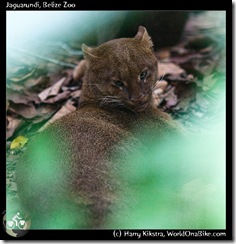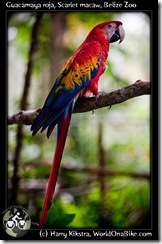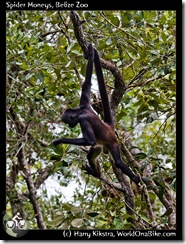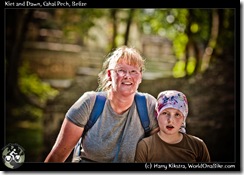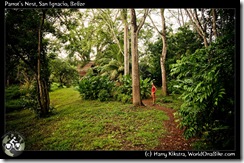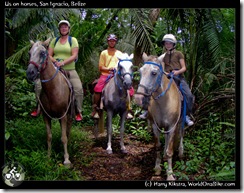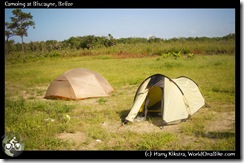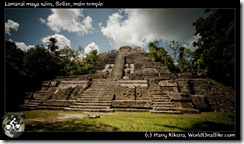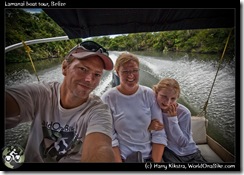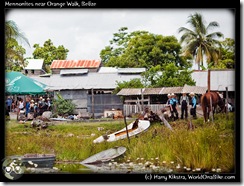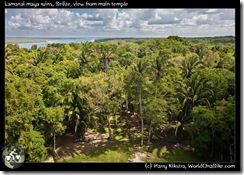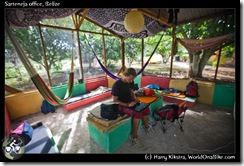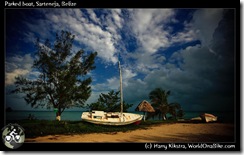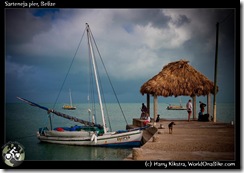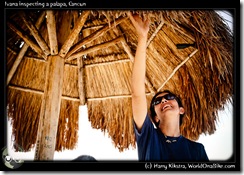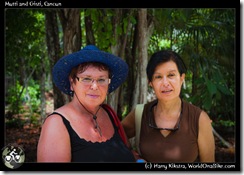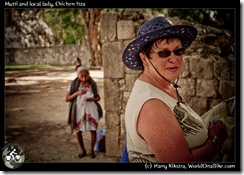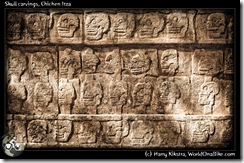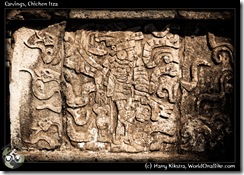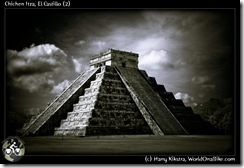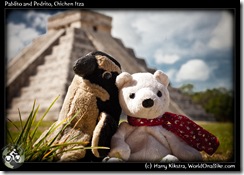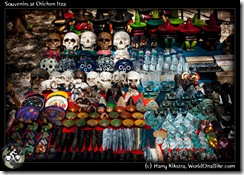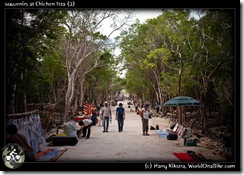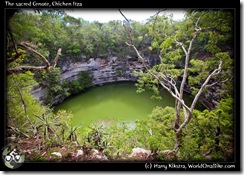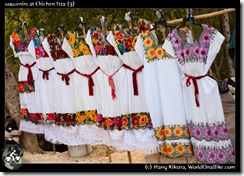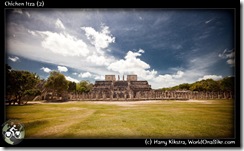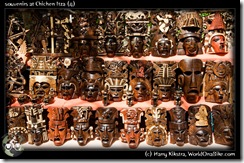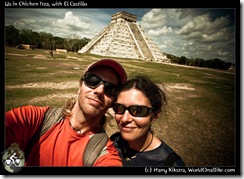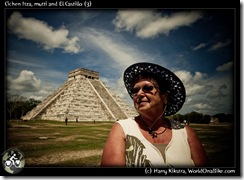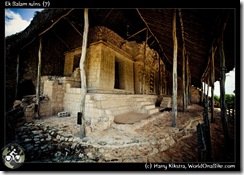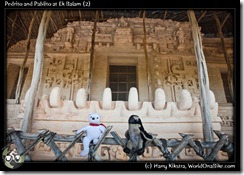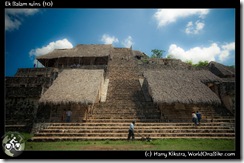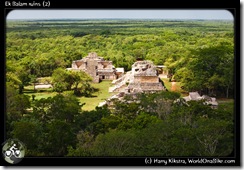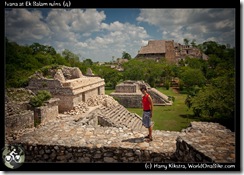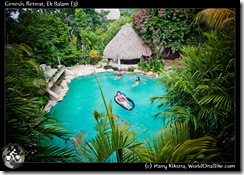Day 384-393, 30jul-8 Aug 09: Animals, Jungle, Ruins, Boats & Buses: interior & Northern Belize
October 30, 2009 by Harry
Filed under Trip reports, Central America, Belize
 It was great to see my only sister Margriet and her daughter/my niece Dawn again, as it had been over a year since we had said goodbye in The Netherlands. She always wanted to go to Belize and as she was tied to my niece’s vacation schedule, we were lucky that we could plan a few weeks together.
It was great to see my only sister Margriet and her daughter/my niece Dawn again, as it had been over a year since we had said goodbye in The Netherlands. She always wanted to go to Belize and as she was tied to my niece’s vacation schedule, we were lucky that we could plan a few weeks together.
 Her entry into Belize was not so easy as the airport personnel was so rude and aggressive that she was crying when she came out of the airport building. On top of that their luggage was delayed, so we had to spend an extra night in Jorge’s place.
Her entry into Belize was not so easy as the airport personnel was so rude and aggressive that she was crying when she came out of the airport building. On top of that their luggage was delayed, so we had to spend an extra night in Jorge’s place.
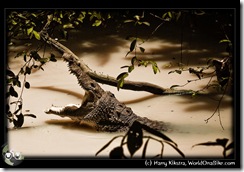 We spent the extra day in Belize City by visiting the famous Belize zoo. a small animal park, started as a shelter after animals were left after a film project.
We spent the extra day in Belize City by visiting the famous Belize zoo. a small animal park, started as a shelter after animals were left after a film project.
Now they shelter more and more animals and though I generally dislike captive animals on display, this was not too bad. 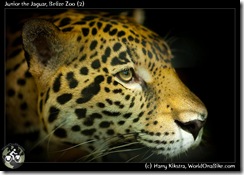
S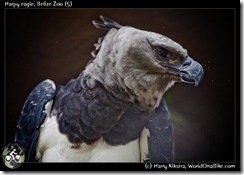 ome of the animals had very little space, others had more, but all were surrounded by a thick jungle, so you could feel like an explorer, meeting al 5 cats of Belize, the largest eagle in the world and much more..
ome of the animals had very little space, others had more, but all were surrounded by a thick jungle, so you could feel like an explorer, meeting al 5 cats of Belize, the largest eagle in the world and much more..
To the West: Ruins, Horses and Parrots’ Nests in San Ignacio
 After the luggage finally arrived, we said our thanks and goodbyes to Jorge, who had patiently helped us out, and boarded a bus West. All ‘public’ buses are privately owned and they are all refurbished USA school buses. This means tights spaces, no luxury and loads of diesel fumes.
After the luggage finally arrived, we said our thanks and goodbyes to Jorge, who had patiently helped us out, and boarded a bus West. All ‘public’ buses are privately owned and they are all refurbished USA school buses. This means tights spaces, no luxury and loads of diesel fumes.
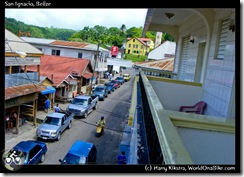 The fun thing is to see the diversity of people inside the buses: the Creoles, the Mennonites, the Mayas, the Guatemalans and the tourists all travel together for a few dollars.
The fun thing is to see the diversity of people inside the buses: the Creoles, the Mennonites, the Mayas, the Guatemalans and the tourists all travel together for a few dollars. 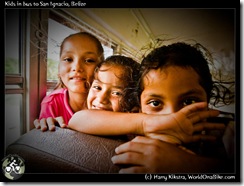 The Western Highway leads past the capital of Belmopan towards the main town of San Ignacio, just 20km from the Guatemalan border.
The Western Highway leads past the capital of Belmopan towards the main town of San Ignacio, just 20km from the Guatemalan border.
 it is a well-known tourist spot, located in the hills and many foreign-owned eco-lodges are located here, in the midst of jungle, ruins and caves, while the famous Maya site of Tikal, Guatemala is only a few hours away.
it is a well-known tourist spot, located in the hills and many foreign-owned eco-lodges are located here, in the midst of jungle, ruins and caves, while the famous Maya site of Tikal, Guatemala is only a few hours away.
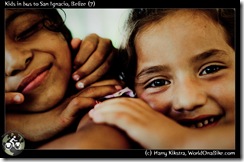 I had seen it 9 years ago when I first visited Guatemala and would have loved to see how it had changed. But due to the expensive (single entry!) visa for Ivana and the exit taxes we would all have to pay, we decided to skip Tikal in favour of some local sights.
I had seen it 9 years ago when I first visited Guatemala and would have loved to see how it had changed. But due to the expensive (single entry!) visa for Ivana and the exit taxes we would all have to pay, we decided to skip Tikal in favour of some local sights.
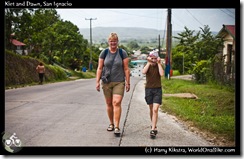 Just outside of town was a small Maya site named Cahal Pech, which was not much more than a few big buildings on top of a jungle covered hill, but that was exactly the charm.
Just outside of town was a small Maya site named Cahal Pech, which was not much more than a few big buildings on top of a jungle covered hill, but that was exactly the charm.
No other visitors had hiked up the steep hill and we could explore the ruins alone and Margriet & Dawn enjoyed it tremendously.
CouchSurfing and horse riding around the Parrot’s Nest

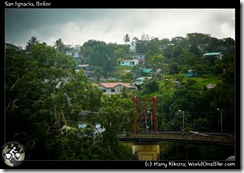 We had gotten in contact with yet another CouchSurfing host, Marcus. Originally from the US, he works as a teacher in a small town and enjoys the eco-lodge he runs with his wife Theo.
We had gotten in contact with yet another CouchSurfing host, Marcus. Originally from the US, he works as a teacher in a small town and enjoys the eco-lodge he runs with his wife Theo.
The Parrot’s Nest is a great place to relax, float on the river, watch the giant lizards and butterflies and to awake at the sound of toucans chatting away.
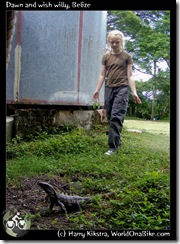 Dawn really wanted to ride a horse and so Margriet & I joined her on a nice ride of several hours.
Dawn really wanted to ride a horse and so Margriet & I joined her on a nice ride of several hours.
We rode through thick jungle, up steep hills, past hidden ruins and friendly people.
Back to the North: Lamanai Ruins via Croc-land and Biscayne
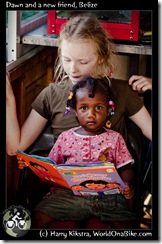 We had to get back to Belize City before we could take another us up the Northern Highway. Ivana & I had seen a place named Croc land, which seemed like a fun place: some crocodiles and the largest swimming pool of Belize ((without crocs :)).
We had to get back to Belize City before we could take another us up the Northern Highway. Ivana & I had seen a place named Croc land, which seemed like a fun place: some crocodiles and the largest swimming pool of Belize ((without crocs :)).
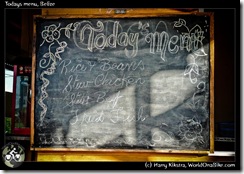 First we camped in another place we had scouted out: a small grocery store that had a camping space and a shower! Dawn spent time playing with the kids and we had our very first ‘Rice & Beans’ in Belize.
First we camped in another place we had scouted out: a small grocery store that had a camping space and a shower! Dawn spent time playing with the kids and we had our very first ‘Rice & Beans’ in Belize.
The swimming pool in Croc Land was indeed very nice, and we enjoyed it, but upon further inspection it turned out that Croc-Land not only housed a few dozen Crocodiles in horrible circumstances but also other animals including a mountain lion and even a jaguar, hidden away in a far corner; going mad in a concrete cage without shade. This place should be shut down immediately…
Back in time on the New River
 I wanted to show them at least one more bigger Maya site and we decided to go to Lamanai. This old Maya centre is located next to one of the largest rivers in Belize and though it boasts some very impressive grand buildings, the boat tour to get there is just as fun.
I wanted to show them at least one more bigger Maya site and we decided to go to Lamanai. This old Maya centre is located next to one of the largest rivers in Belize and though it boasts some very impressive grand buildings, the boat tour to get there is just as fun.
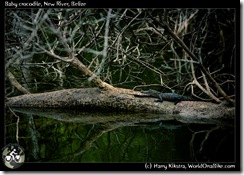 The captain clearly loved his job and pointed out every bird, baby crocs, bats and the Mennonite community along the way.
The captain clearly loved his job and pointed out every bird, baby crocs, bats and the Mennonite community along the way.
He slowly passed some Spider Monkeys, to give them a chance to grab some bananas off the boat and then went at full speed through some of the other curves of the river before showing us around the historical sites. It was hot and the bugs were attacking, but still a great day out.
Orange Walk to Sarteneja.
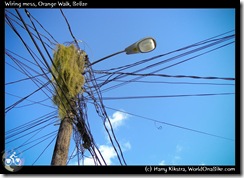 We returned too late to get to our next destination, so we decided to skip Corozal as planned and stayed another night in Orange Walk, enjoying Guatemalan tamales & Salvadorian pupusas off the street.
We returned too late to get to our next destination, so we decided to skip Corozal as planned and stayed another night in Orange Walk, enjoying Guatemalan tamales & Salvadorian pupusas off the street.
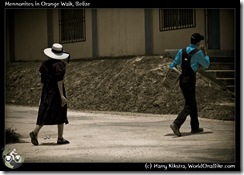 We skipped Corozal in favour of Sarteneja, an even smaller coastal town where two backpackers had opened up a small eco-place called The back-packer’s Paradise.
We skipped Corozal in favour of Sarteneja, an even smaller coastal town where two backpackers had opened up a small eco-place called The back-packer’s Paradise.
We stayed 2 nights while swimming in the warm Corozal bay. ahh, the hard life of the Bike Travellers 🙂
Coming up: Belize with Family, part 2 (final): La Isla Bonita
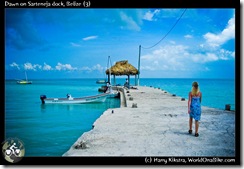 It was time to head out to the pier and grab a boat to visit the best-known places in Belize.
It was time to head out to the pier and grab a boat to visit the best-known places in Belize.
Remember when Madonna sang about the place with the Tropical Breeze, this was where she wanted to be?
Next stop: San Pedro, “La Isla Bonita”…
Day 375-380, 21-26July 09: Interviews, fever, topes, laguna: down to Belize
October 17, 2009 by Harry
Filed under Trip reports, North America, Mexico, Yucatan Peninsula
Happy B-day to me! My 2nd one on this trip and likely not the last… But there were a lot of things to do, no time to celebrate. I woke up with a very sore throat, but reckoned that it was he airco’s fault and did not think much of it.
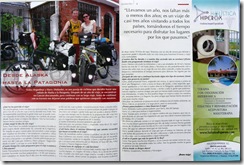 Ivana & I took our mums back to the airport in two separate transfers and then went over to Veronica & Hector to collect our stuff. We could have stayed with them again, but we had to get started to Belize, where my sister would arrive in 8 days time, so we said goodbye to our good friends that had helped us out so much.
Ivana & I took our mums back to the airport in two separate transfers and then went over to Veronica & Hector to collect our stuff. We could have stayed with them again, but we had to get started to Belize, where my sister would arrive in 8 days time, so we said goodbye to our good friends that had helped us out so much.
Hector took a nice photo of us outside their home and sent us an article in a magazine a while later, if you read Spanish you can click on the mage to the right to read it:
Hector also did a video interview, which can be seen here, in 2 parts on the video & interview page (in Spanish mostly).
The wind-gods were merciful for our first day on the bike in about a month, and we cruised the 70km Playa del Carmen in less than 4 hours. My throat did not feel so bad, but I was starting to get a huge headache, so I took one of the new migraine pills that Cristi had taken from Argentina. It did not get much better.
Our CouchSurfing host Ulises –who even spoke some Dutch thanks to his GF- had another guest coming and we went to pick her up together in the crazy downtown of PdC. Back home I crashed completely, with a big fever as an addition to the migraine, and could not appreciated the veggie ceviche that Ulises made as I would normally do. I stumbled to bed and felt hot and cold at the same time, not sleeping or resting much and awoke feeling I had plundered a cheap tequila bar the night before.
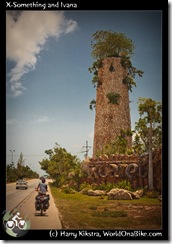 Ulises offered us to stay another day to recover, but as we did not have many spare days and it was only 45km to Tulum, we headed out. It was flat and boring again and we passed yet more places starting with an ‘X’ and containing ‘zip lines’ and other ‘eco-adventures’ like ruining the jungle with quads.
Ulises offered us to stay another day to recover, but as we did not have many spare days and it was only 45km to Tulum, we headed out. It was flat and boring again and we passed yet more places starting with an ‘X’ and containing ‘zip lines’ and other ‘eco-adventures’ like ruining the jungle with quads.
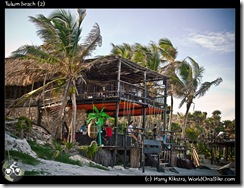 If the resorts do not start with an X, it is Not Maya and Not Fun Nor Adventurous. We were glad we were getting out of the reach of the Zona Hotelera, on the far horizon loomed the real world again…
If the resorts do not start with an X, it is Not Maya and Not Fun Nor Adventurous. We were glad we were getting out of the reach of the Zona Hotelera, on the far horizon loomed the real world again…
But first we planned to do a quick stop in Tulum, where yet another CouchSurfer was waiting.
I was far from a ‘Spanish’ mood. Usually I get tired of speaking, reading and hearing Spanish some time in the afternoon, but now I had already woken up exhausted and was happy that Lianne was Dutch, as my head was exploding and no other tongue worked.
 I do not remember much of the following 24 hours as I was sweating, hallucinating and trapped in some lost space-time continuum. Only at the end of the next day I had enough energy to cycle the 3km to the beach, where I had to lie down to recover and we stayed another night with Lianne.
I do not remember much of the following 24 hours as I was sweating, hallucinating and trapped in some lost space-time continuum. Only at the end of the next day I had enough energy to cycle the 3km to the beach, where I had to lie down to recover and we stayed another night with Lianne.
Mexican culture bonus: Topes
We have discussed a lot about Mexico in our recent updates covering the 4 months (!) we crossed the entire country from one side to another. The friendly people, the cities, the culture, the food, the nature.
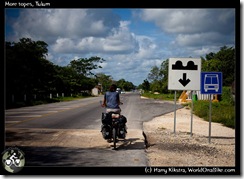 One very important thing I have not mentioned yet, while it is maybe one of the most important and widespread aspects of Mexican history when seeing through a cyclist’s glasses (which are usually a lot clearer than a driver’s glasses :))
One very important thing I have not mentioned yet, while it is maybe one of the most important and widespread aspects of Mexican history when seeing through a cyclist’s glasses (which are usually a lot clearer than a driver’s glasses :))
The Mexican love for speed-reducing things on the roads. As Mexicans are used to the fact that all major roads pass right through the middle of small towns, they are not used to slow down when they are driving and entering a pueblo.
Fines are seldom given and modern radar machinery seems confined to the Mexico DF limits. Threats like that do not work in the more short-term oriented parts of the world anyway, a practical and immediate solution was needed.
So they created bumps. Not those sissy bumps you see in the rest of the world, but real, car wrecking bumps in all shapes and sizes. Some of these, like the ones above are no problem for us as they are smooth. But the serious ones can really break your bike if you are not prepared and do not almost stop completely. I guess that is the point, though a bit moot for bikes.
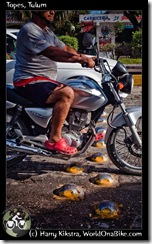 Some newer variations include 1-3 rows of metal domes, firmly attached to the ground. Sometimes local villagers (the ones that are not living in a 25 meter radius of the tope (Toh-puh)) manage to remove just enough so they can pass their vehicles at full speed, but most of the time they cover the entire road.
Some newer variations include 1-3 rows of metal domes, firmly attached to the ground. Sometimes local villagers (the ones that are not living in a 25 meter radius of the tope (Toh-puh)) manage to remove just enough so they can pass their vehicles at full speed, but most of the time they cover the entire road.
Whereas in the Netherlands, they would leave a gap for bicycles to pass safely, in Mexico this would invite drivers to use that gap. Actually even the shoulders of the road, so usually the topes are extended all the way across the dirt on the side. Some of the metal ones are quite dangerous, as the only ‘safe’ way to cross them on a bicycle is to approach them in a 45 degree angle and aim well. This is already a decent challenge, but of course in heavy traffic it takes on other dimensions – you also exit at the same angle if you managed not to fall over, so either while entering or exiting you end up in the middle of the lane.
If your angle is a few degrees off, your grip on the handle bars is not firm or the topes are too close together, there is a big chance you drop in front of some hungry diesel-stricken wheels. You can get off the bike and walk, but after the 4600th tope in a row, this gets old. Be warned for this authentic part of Mexican culture and you will still be amazed.
24th July 2009: Tulum to Felipe Carrillo Puerto, 90km
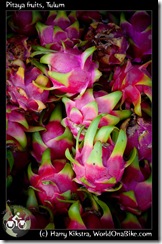 By now we had to hurry more than we wanted, but at least the roads through the stats of Quintana Roo are mostly flat, so it is easy to make some miles.
By now we had to hurry more than we wanted, but at least the roads through the stats of Quintana Roo are mostly flat, so it is easy to make some miles.
It was hot though and though I felt a bit better, I was cursing a lot when I got a flat in the middle of the hot day and it came off . I already hated my new back tire. The old Schwalbe Marathon tyre was actually still good after almost 11,000km/ 7000miles, but my mum had brought a new foldable version, that I had left with her in The Netherlands before departure. Normally I am a firm believer in the ‘if it ain’t broke, don’ fix it’ adagio, but as we had never replaced any tires and I still had another foldable tyre, I decided to change the back one on my bike.
I love the Marathons and the foldable is very useful as it fits neatly on the bottom the Ortlieb bags, but it is much better if they stay there. They are a royal pain in the saddle-sored behind to get on the wheel the first time and it does not get much easier after that. I do not like the fact that I had more flat tires in the first week of using them than the first 6 months of the other one, it seems that there are more differences between the 2 types beside the missing metal wire to make it foldable.
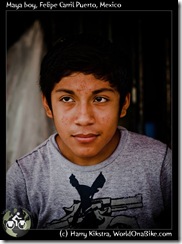 Just before reaching the town I had gotten another flat that I could not fix as one tube exploded when the foldable tire went outside the rim when almost fully inflated. The spare tube we were carrying somehow got a hole on the inside of the wheel and would not hold on to the patches.
Just before reaching the town I had gotten another flat that I could not fix as one tube exploded when the foldable tire went outside the rim when almost fully inflated. The spare tube we were carrying somehow got a hole on the inside of the wheel and would not hold on to the patches.
As one local motorist had already said that the Police would be able to help if needed, we decided that Ivana would cycle ahead and I would wait for her to return with the cops. Within 20 minutes a police pick-up came up to me and stopped on the side of the road. I walked up to them with my bike, but first had to identify myself.
‘What is your name?’ The officer asked surprisingly.
When I told him, he carefully compared my answer with the name that he had written in his notebook when Ivana told him about me. It took a minute or so, but after I also told him where I was from and that I really was the one that had sent Ivana for them to pick me up, he finally nodded and let me load Kowalski in the back. Apparently there were a lot of long-haired blond Dutchmen with a fully loaded bike with a flat tire just outside of the city limits and they had to take care not to pick up the wrong one…
Unlike the name suggests, FC Puerto does not have a harbour as it is inland. It is named after a revolutionary Zapatista from Mayan descent, who even had governed here for a short while. The city is still considered as a Maya ‘capital’ and the look and feel showed us that we had left the rich zone of Mexico.
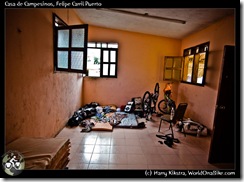 Finding a place to camp in the spacious city with lawns everywhere turned out to be a bureaucratic problem. The police decided that it was not safe to camp with them and took us and our bikes to the Firemen. After long discussions on the radio with lots of code numbers (they seemed to have a special code for stranded Argentinean/Dutch BikeTravellers) it was decided that, no, we could not sleep inside or outside the fire station, either.
Finding a place to camp in the spacious city with lawns everywhere turned out to be a bureaucratic problem. The police decided that it was not safe to camp with them and took us and our bikes to the Firemen. After long discussions on the radio with lots of code numbers (they seemed to have a special code for stranded Argentinean/Dutch BikeTravellers) it was decided that, no, we could not sleep inside or outside the fire station, either.
Meanwhile we had lost hours and it had become pitch dark, while I was feeling exhausted again. We finally ended up in the ‘Casa de Campesinos’, a small building with some mattresses, used by the local farmers coming from far away villages. I finally got to fix my bike while Ivana found some food and though we had the room to ourselves it was too hot to sleep properly…
25th July 2009: FC Puerto – Bacalar – 10km + a ride
After getting freshly squeezed juice and new tubes at the local bike shop, we headed out of the city. There were some very minor hills, and it was still relatively cool, but I totally crashed after 10km. Not in the sense of falling over or introducing Kowalski to a passing truck, but I simply could not cycle anymore. The flu had come back, I was overheating and could hardly sit down without passing out.
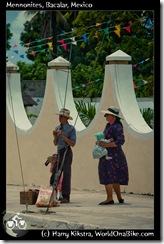 After a while a pick-up truck passed that picked us, well, up and took us all the way to Bacalar, almost 100km away. It not only saved me from committing high-temperature velocipedal suicide, but also took a lot of pressure off, distance- and time-wise.
After a while a pick-up truck passed that picked us, well, up and took us all the way to Bacalar, almost 100km away. It not only saved me from committing high-temperature velocipedal suicide, but also took a lot of pressure off, distance- and time-wise.
Bacalar is one of the Pueblos Magicos, a list of 27 towns and cities in Mexico with special cultural or religious backgrounds, and that leave their visitors with a special feeling; in a positive way that is. We had only been to one other Magic Town, Patzcuaro, and that one was nice.
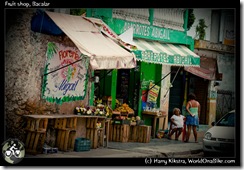 Bacalar was less spectacular, but maybe it would have been better without a flu.
Bacalar was less spectacular, but maybe it would have been better without a flu.
The centre is nice and they have a wonderful multicoloured lake where Ivana spent some hours floating, while I was resting in the cool breeze coming off it.
We stayed with Codrut, a friend of a CouchSurfing host in Bacalar. I spent most of the time resting and recovering and took a huge dose of anti flu and migraine pills. We decided to sleep outside on the porch, just on our mattresses as again it was too hot to be inside, and this time it wasn’t just me…
Here are some pix, so it might give you an idea of why so many gringos have bought all the land surrounding the lake:
Leaving Mexico for Belize
As Etta James would sing: At last.
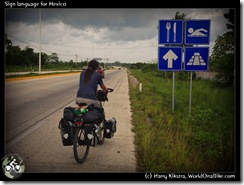 But not with a feeling of relief, but with a little pain in our hearts, homesickness to a new home. We had spent 4 months in this amazing place and though we literally crossed it from North West to South East and from Sea level to the highest peak, after 3000km/1900Mi of cycling and more than 1300km of rides we still felt we had only tasted a drop of the cultural and natural waterfall Mexico has to offer.
But not with a feeling of relief, but with a little pain in our hearts, homesickness to a new home. We had spent 4 months in this amazing place and though we literally crossed it from North West to South East and from Sea level to the highest peak, after 3000km/1900Mi of cycling and more than 1300km of rides we still felt we had only tasted a drop of the cultural and natural waterfall Mexico has to offer.
We were very happy to be able to tell our friends and family that we had zero real problems. I might have had the (swine?) flu, nearly overdosed on tasteless tortillas at times; we had some of the hottest nights in our lives and Ivana almost got run over by a truck.
We also met hundreds of kind people, saw historic sights, swam in sinkholes, felt like Indiana Jones, ate the best food, overdosed on fruits we had never even heard of before, camped in the desert, sailed between dolphins, visited magic towns, enjoyed the lazy beach life and climbed a glacier to the highest point between Canadian Mount Logan and Pico Cristobal Colon in the Columbian Andes.
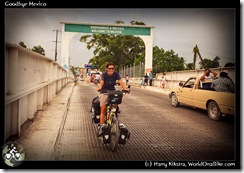 We hope to come back to Mexico some day, not to see a little bit of the rest this country has to offer, but also to meet our dozens of good new friends again.
We hope to come back to Mexico some day, not to see a little bit of the rest this country has to offer, but also to meet our dozens of good new friends again.
Thank you, Mexico.
Next stop: Belize!
Day 354-360, 30Jun-6Jul 09: Mums in Mexico pt.1: Ruins & Cenotes!
September 26, 2009 by Harry
Filed under Trip reports, North America, Mexico, Yucatan Peninsula
Photos: relaxing in Cancun
We started our holiday with a few days in a Hostel and some visits to the beach as well as the nice local park. The park is not visited much, but is basically a part of original jungle in the middle of the city. It has some great trails, a turtle pond, many lizards walking around and we even saw a snake.
Off to the Maya Ruins: Chichen Itza!
Of course you cannot visit Central America without visiting at least some of the ancient Maya cities. Cancun is quite close to Chichen Itza, maybe the most famous city of them all, especially after a huge marketing campaign managed to get it entered as one of the new 7 wonders of the world.
We had rented a cheap car for a week, so we could tour around for a while, leaving the beaches for later. Our mums experienced a hint of our way of life when we told them that they could only take 1/3 of their luggage –as more did not fit in the tiny car- and that they would see the rest only in a week 🙂
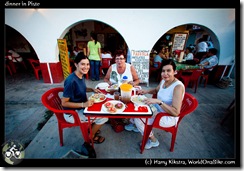 There is a wonderful new highway from Cancun to Chichen Itza, but we only found out why it was so deserted (we saw 2 cars in 200km), when we needed to pay over USD 20 in toll fees, close to the exit. Now we understand why Francisco and the other truckers all choose the ‘Libre’ road instead.
There is a wonderful new highway from Cancun to Chichen Itza, but we only found out why it was so deserted (we saw 2 cars in 200km), when we needed to pay over USD 20 in toll fees, close to the exit. Now we understand why Francisco and the other truckers all choose the ‘Libre’ road instead.
The mums got another taste of our trip when we booked them in a small but cheap guesthouse, with 3 beds in a dusty and very hot room in Piste, the town next to the old Maya City. We had arrived in the afternoon, so we had time to have some dinner and go to Chichen Itza for the evening show. 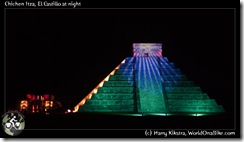 Most people do not see this as they come on day trips from Cancun & Merida, but every evening the main structures are illuminated at sunset, while a set of voices tell about the history and legends of Chichen Itza.
Most people do not see this as they come on day trips from Cancun & Merida, but every evening the main structures are illuminated at sunset, while a set of voices tell about the history and legends of Chichen Itza.
The Spanish whispering was a bit too much for me, but it was nice to sit in the fresh breeze while the most famous main structure, the temple of Kukulkan, better known as ‘El Castillo’ -the castle- turned form green to purple.
Here is a photo impression (click to enlarge, more photos in the photo section here).
Souvenirs & Cenotes
Of course the place is stuffed with souvenirs and other semi-local handicrafts. The sacbe number 1, the ancient Mayan road, leading to the ‘cenote’ was lined with vendors. The Yucatan peninsula is lined with Cenotes, which can be anything from a large pond to a huge underground cave filled with water. The soft limestone base of the peninsula combined with tropical rainfall had created these holes and many of them were either sacred or at least an important water source.
The cenote at Chichen Itza was found to contain several artefacts and bones, it was clearly used as a sacrificial place. Some more pix 🙂 :
Swimming in the Cenotes
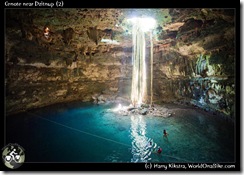
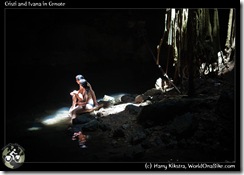
 Not all cenotes are closed to the public. In fact there is a large tourism sector focused on either swimming in them or even exploring them while diving, as many are connected by underground rivers. We stuck to swimming in a couple, with the first one being close to the town of Dzitnup.
Not all cenotes are closed to the public. In fact there is a large tourism sector focused on either swimming in them or even exploring them while diving, as many are connected by underground rivers. We stuck to swimming in a couple, with the first one being close to the town of Dzitnup.
The cenote is inside a huge a cave, but it had a hole on top where sunlight shines through. next to the hole grows a tree and it roots come all the way down to the water, a magic place for sure..
Jungle ruins: Ek Balam
 The ruins of Chichen Itza are the most famous, but its popularity has caused some downsides. You can no longer climb on El Castillo as a tourist had fallen to her death a few years ago and the sheer number of visitors can cause irreplaceable dame to the structure.
The ruins of Chichen Itza are the most famous, but its popularity has caused some downsides. You can no longer climb on El Castillo as a tourist had fallen to her death a few years ago and the sheer number of visitors can cause irreplaceable dame to the structure.
Also most of the other structures are off-limits now, meaning you can only see them from a (short) distance.
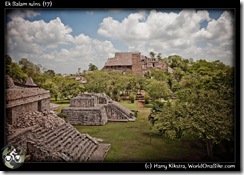 Therefore it was nice to visit a much ‘newer’ site, Ek Balam. Largely unknown for mass tourism, but with some impressive structures, of which the 2nd and 3rd largest are still unexcavated and buried by the force of nature.
Therefore it was nice to visit a much ‘newer’ site, Ek Balam. Largely unknown for mass tourism, but with some impressive structures, of which the 2nd and 3rd largest are still unexcavated and buried by the force of nature.
The highest structure, known as the Acropolis, can be climbed on its narrow and sloping steps, offering great views over the site and the surrounding jungle.
Somehow, it felt more ‘real’ being here compared to Chichen Itza. An impression:
X’Canche & Genesis: Swimming and relaxing in Ek Balam

 Ek Balam had one bonus: it has an open Cenote (meaning open to the public, you still have to pay an entrance fee) a 15 minute walk from the ruins.
Ek Balam had one bonus: it has an open Cenote (meaning open to the public, you still have to pay an entrance fee) a 15 minute walk from the ruins.
This one was open, but also had many roots growing into it, as well as many fishes and plant and we enjoyed the cooling water as well as the collection of free hammocks nearby.
We had spent a few days in the wonderful Genesis Resort in the nearby village of Ek Balam, run by Lee Christie. A nice oasis in the dry surroundings, it had a great swimming pool and evens some bike for rent. In exchange for a discount on the price of the room, we cleaned and fixed the bikes, so that they were safe again 🙂
On the road again
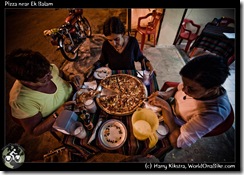 After a huge pizza in a nearby village, and some clothes testing for Pablito and Pedrito, it was time to hit the road again. Not to the ruins and beaches of Coba & Tulum as planned, but back to Cancun, this time on the libre road. Ivana had to undergo a second part of a dental treatment, as part of her tooth had broken off the day our mums arrived.
After a huge pizza in a nearby village, and some clothes testing for Pablito and Pedrito, it was time to hit the road again. Not to the ruins and beaches of Coba & Tulum as planned, but back to Cancun, this time on the libre road. Ivana had to undergo a second part of a dental treatment, as part of her tooth had broken off the day our mums arrived.
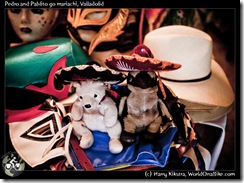 It was fixed ok, but the next problem was that both Cristi as well as myself developed a rash on our legs and arms, there must have been something in the Cenote water, though Ivana had no problems.
It was fixed ok, but the next problem was that both Cristi as well as myself developed a rash on our legs and arms, there must have been something in the Cenote water, though Ivana had no problems.
It was time to hit the other famous parts of the Yucatan Peninsula: the beaches!



